Everything You Need to Know About Bubble Tea
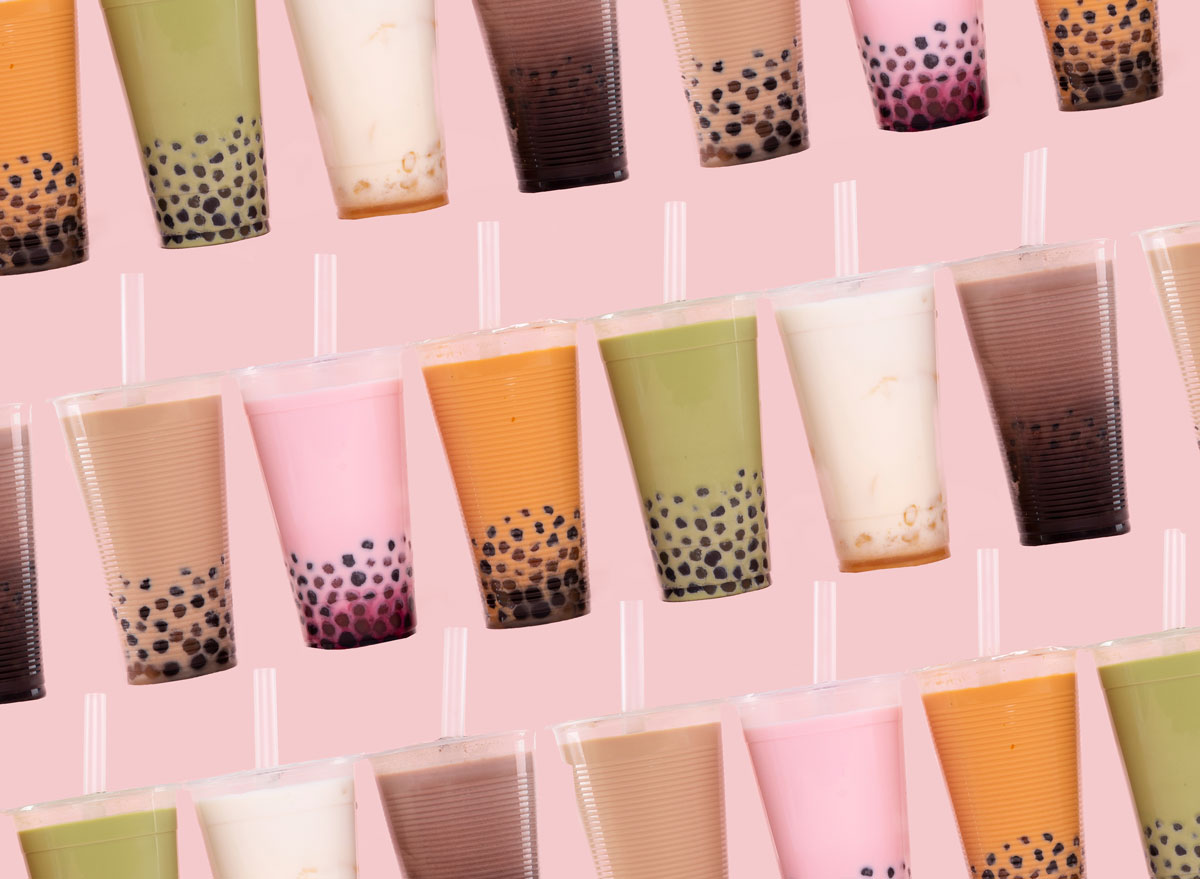
Bring up “bubble tea,” and people’s ears are bound to perk up. The other day at the Eat This, Not That! headquarters in New York, a couple of us were talking about it (boba…bubble..what is it, exactly?) and our resident tea aficionado and author of The 7-Day Flat-Belly Tea Cleanse, Kelly Choi, immediately launched into all these fun facts about the colorful concoctions we’ve seen around the city.
“It’s not good for you at all, though,” Kelly revealed. “It has so much sugar. But people like it because it’s kinda fun to drink and it’s not like they’re drinking soda. And maybe they’ll choose a tea that’s actually good for them next time!” (Like green tea, which has been proven over and over to aid weight loss and what inspired her bestselling book!)
Jumping on the restaurant industry’s successful build-your-own model that’s been popping up everywhere (think: Chipotle), bubble tea’s customer customization has helped the drink grow in popularity over the last two decades in the States.
While the drink got its start in Taiwan—where bubble tea shops can be found on nearly every corner—it has also spread to neighboring countries like Japan, South Korea, and China and then to the rest of the world, including the U.S. during the mid-1990s.
Bubble tea remains a mystery to most Westerners, but it’s becoming increasingly more well known. There are now over 800 shops in the U.S., mostly concentrated in New York and California, and shops have been spotted in over 30 countries.
Back to the bubble tea, though. It’s trending, so it’s time to get filled in—especially before you go and place an order.
What is bubble tea?
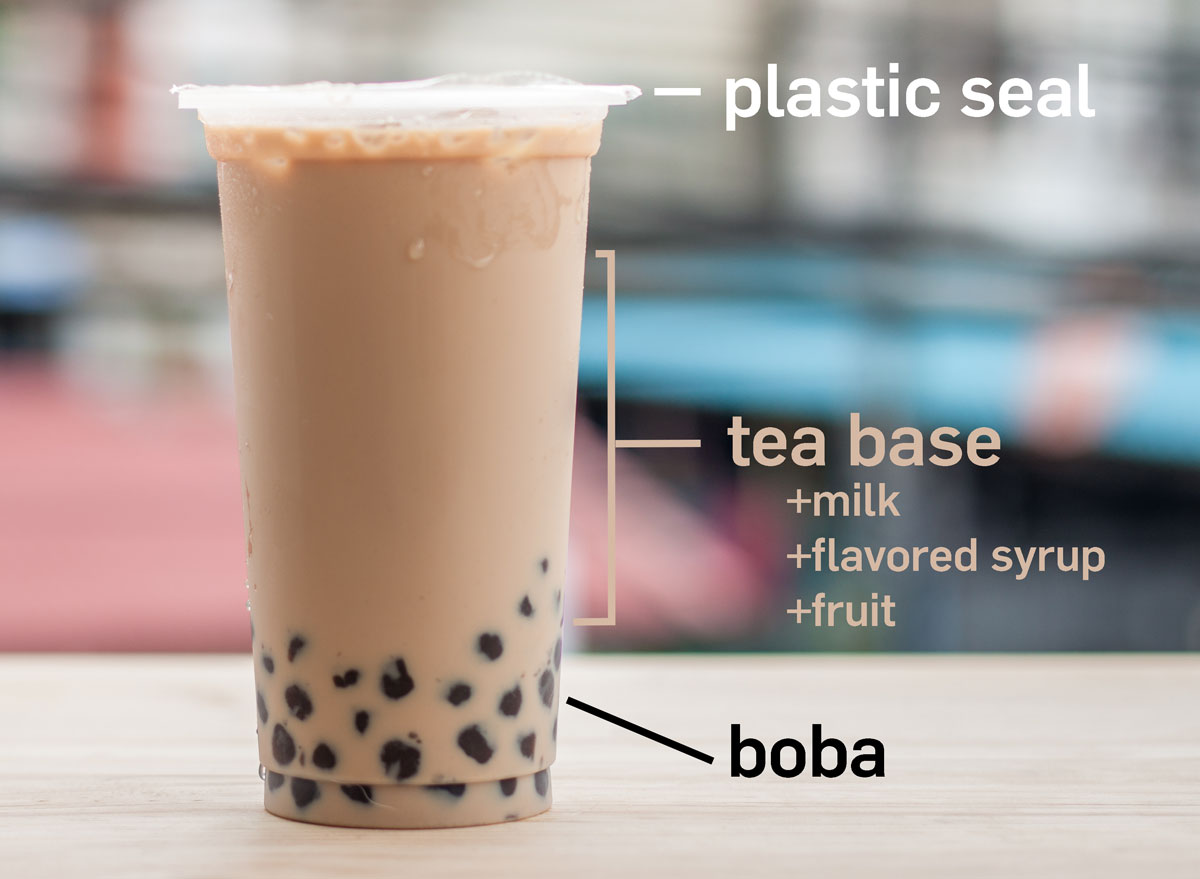
Bubble tea is a Taiwanese iced tea that has a layer of chewy tapioca balls that sit on the bottom.
Consisting of a tea base mixed with milk, fruit, flavored syrups, and tapioca pearls, bubble tea is a fun and delicious treat to drink.
While some tea shops use the same plastic dome-shaped lids that you see on Slurpees, many bubble tea bars have started to serve it in a cup that has been completely sealed. A machine seals the top of the cup with plastic cellophane, which allows the tea to be vigorously shaken in the serving cup and makes it spill-free until you’re ready to drink it. Just pierce the cellophane seal with your straw.
What’s in a name?
Bubble tea is only one of many popular names for this beverage. It’s also called milk tea, pearl tea, tapioca tea, boba tea, boba nai cha, foam milk tea, momi milk tea, Q (which means chewy in Chinese), and many others.
The name ‘bubble tea’ doesn’t actually refer to the ‘bubble-like’ tapioca pearls found on the bottom.
Most people think the name “bubble tea” refers to the round, bubble-like tapioca pearls at the bottom of your cup, but it actually refers to the bubble foam on top of the drink. “Bubble tea” was first made without the addition of tapioca pearls. This drink was found in Taiwanese specialty restaurants and commonly prepared by shaking the ice, milk, tea, and sugar in a cocktail shaker which resulted in a lot of bubbly foam. This same preparation method is used for bubble tea, just now with the added pearls/boba.
Keep reading to find out more about what bubble tea is, how it was invented, and how to order your own!
Bubble tea nutrition: how many calories are in bubble tea?
Due to the customization of bubble tea depending on which tea shop you go to, it’s impossible to give one answer to the question of how many calories are in bubble tea.
However, we were able to track down the nutrition information provided by one shop in Texas: Fat Straws.
For a Classic Milk Tea (16 fluid ounce serving), the nutrition of bubble tea is: 212 calories and 37 g sugar.
A 24 fluid-ounce serving of Classic Milk Tea: 243 calories and 63 g sugar.
Recently a Food Science & Nutrition study analyzed the nutritional content of bubble teas from a Los Angeles-based boba chain store. The researchers found the following nutritional information:
Milk Tea + Tapioca Boba (16 oz): 299 calories, 38 grams of sugar
Milk Tea + Tapioca Boba (32 oz): 448 calories, 57 grams of sugar
For comparison, your typical 12-ounce can of Coca-Cola is 140 calories and has 39 grams of sugar. A 20-ounce bottle of Coca-Cola is similar to the 24-ounce Classic Milk Tea nutrition: 240 calories and 65 grams of sugar.
A note on the healthfulness of bubble tea: These drinks may be fun and playful, but be cautious about how much you drink. One published study suggested that boba tea drinks should earn a spot in the group of sugar‐sweetened beverages (the same one that soda falls in). Plus, the Food Science & Nutrition study points out that because boba drinks have similar calories and sugar content as other sugar-sweetened beverages, the popularity of these drinks should be considered a significant public health concern.
What’s everything I need to know about boba?
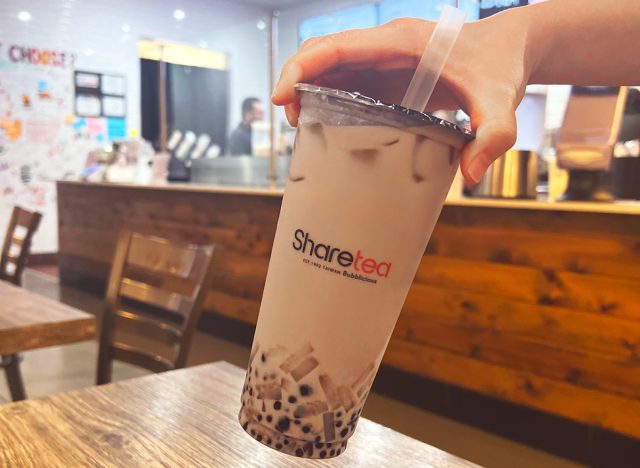
Boba = Tapioca Pearls = Cassava Root
Recognized more commonly in tapioca pudding, tapioca pearls are made from starch extracted from cassava root. Cassava is a nutty-flavored tuber native to South America. This root vegetable is a major food staple in the developing world as it has nearly twice the calories of potatoes—primarily from carbs and sugar—and is thus a large source of energy. If you thought its lack of nutrients was bad, get this: cassava can be toxic when eaten raw. The tapioca starch has to be detoxified before consumption due to its levels of cyanide, a toxic compound that when ingested can cause headaches, nausea, vomiting, and even paralysis.
Boba Doesn’t Mean What You Think It Means
In Taiwan, it’s more common for people to refer to the drink as pearl milk tea (zhēn zhū nǎi chá, 珍珠奶茶) because originally small 1/12″ tapioca pearls were used. It was only when one tea shop owner—in an attempt to make his tea stand out—decided to use larger tapioca balls and chose a more provocative name, “boba,” to represent the difference. In Chinese, the word boba, 波霸, is a combination of a word for bubble and a word for big, which, when found together, is slang for “big breasts” or “buxom lady.” When used to describe the drink, the characters 波霸奶茶 directly translate to boba milk tea, and loosely to bubble milk tea. This translation is commonly used by English speakers and refers to the variant with the big, 1/4″ tapioca pearls.
Tapioca Pearls Can Be Brown Or White
To make the tapioca pearls, the moist cassava starch is passed through a sieve. Once dry, it’s then rolled up into little balls. Depending on the ingredients of the pearl, the color varies. Tapioca pearls that are white contain just the cassava root. The brown ones contain cassava root, brown sugar, and sometimes dangerous food dyes, like caramel coloring—a coloring found in soda which contains an artificial form of phosphorous that’s been shown to leach calcium from our bones.
Boba Are Super Chewy
The little starchy brown spheres are plopped into hot water, sometimes with even more added sugar, to cook for no longer than three hours. When boba are overcooked, they can be really mushy and when undercooked the pearls can be crispy or hard. Boba should be smooth and soft on the outside and have a consistency between gummy bears and Swedish fish on the inside. To make it extra chewy (or “QQ”), the boba are chilled quickly after cooking.
And There’s Also A Popping Version!
Although not the traditional style, some bubble teas have started using popping boba. These caviar-like spheres are fruity juice gels that burst in your mouth—no chewing involved. The molecular gastronomy technique, called “reverse spherification,” was developed by Ferran and Albert Adrià in 2003.
What’s the history of bubble tea?
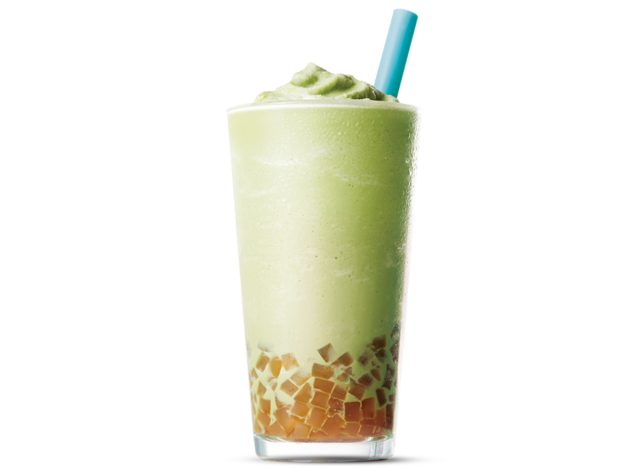
As with many undocumented, unpatented recipe origins, there is much speculation about the origin of bubble tea. But one story is generally accepted to be true: Back in the 1980s, Taiwanese tea stands became increasingly popular businesses as the demand for a refreshing post-work drink increased. As tea stands set up shop on every corner, business owners started to employ product differentiation tactics. To separate himself from the competition, one concession owner at the Chun Shui Tang teahouse in Taichung started serving Chinese tea cold after getting the idea from iced Japanese coffee.
A few years later, his product development manager, Ms. Lin Hsiu Hui, was trying to entertain herself at a boring staff meeting. On the spur of the moment, she decided to dump her Taiwanese dessert called fen yuan—a sweetened tapioca pudding—into her Assam iced tea and drank it. It was so good that they decided to add it to the menu, where it soon became the franchise’s top-selling product. Soon after seeing the success of this drink at one teahouse, concessions all over Taiwan started adding tapioca pearls and different fruit flavors to their iced teas, and so began bubble tea as we now know it.
7 steps to follow to order the best bubble tea.
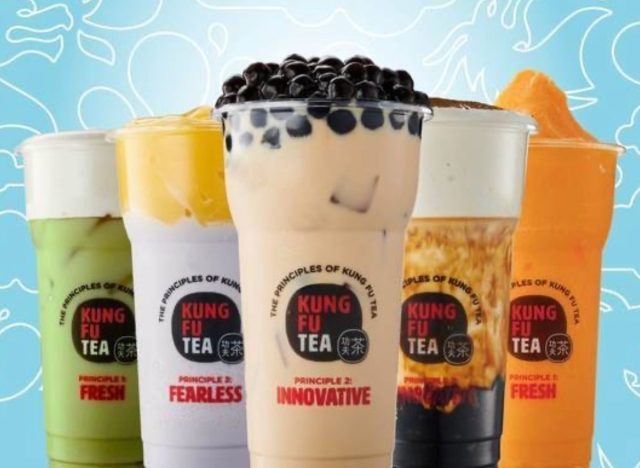
You can customize bubble tea however you’d like.
Bubble tea shop menus can be pretty complex, but they’re typically laid out with grids and sub-sections to help guide your ordering process. All you have to remember is the classic formula: tea, milk, boba, and flavor. Don’t want to choose your own? Go with a premade one. A lot of tea shops have their own combos to take the stress out of choosing between the hundreds of options.
Start With The Tea
The tea can be green, black, chai, Thai, oolong, or Pu-erh. Tea is packed with antioxidants, and green tea, in particular, has one of the best waist-whittling compounds out there: EGCG, an antioxidant found in green tea, boosts your metabolism which increases the release of fat from belly fat cells and speeds up the liver’s fat-burning capacity. And green tea isn’t the only magic elixir. Research has shown us that the antioxidants found in all teas (as they’re all made from the same plant) can help boost your metabolism, melt belly fat, fight off diseases and even reduce your risk of stroke and cardiovascular disease. The drink has such a strong ability to revolutionize your waistline that test panelists lost up to 10 pounds with our best-selling plan, The 7-Day Flat-Belly Tea Cleanse!
Dairy Milk Or Non-Dairy?
A crucial part of the bubble tea is milk. The milk can be dairy or non-dairy, with many shops offering soy, coconut, almond, or dairy milk and lactose-free creamers. Make sure you’re getting fresh milk products rather than the canned, condensed milk variety. These condensed milks are cut with loads of processed ingredients and artificially sweetened—they can be up to 45 percent sugar!—to make them quite heavy and overpowering.
Pick Your Flavor
This is why you see bubble teas in such a broad array of bright colors. But, it’s also where ordering can get complicated. Bubble teas have flavored (and non-flavored) syrups that control the taste and color of your tea along with how much sweetness is added. Everything from cookie dough, salted caramel, rose, cherry, coconut, melon, strawberry, taro, chocolate, sesame, almond, lavender, peppermint, and even coffee can be used to flavor the drink. If you prefer the real stuff, add fruit pieces of mango, strawberry, apple, orange, blueberry, peach, pineapple or pomegranate seeds among countless others. Fruity flavors pair well with plain teas, and neutral flavors like chocolate, caramel, and coconut pair well with milk teas. And while you’re thinking about your favorite flavors and fruits, find out the 21 Amazing Things Bananas Do to Your Body!
Tapioca Balls Or Jelly?
Similar to the competition among tea shops upon the invention of bubble tea, tea shops are still trying ways to differentiate themselves from other establishments by offering a wide assortment of toppings. Boba isn’t the only thing added to bubble teas now. You can also get popping boba, jelly, and pudding. For pudding teas, the barista can blend the entire pudding into the drink instead of adding a flavoring. Be careful about your combinations, though. The tartness of the fruit jelly and popping boba may not always pair well with the creaminess of the milk.
You Decide How Much Sugar You Want
With all these add-ons, the sugar content can add up. It’s in the pearls, the milk, the syrups, and the fruit. Luckily, most tea shops offer clearly-defined options for levels of sugar, such as none, 25 percent, 50 percent, 75 percent, or 100 percent. Be careful, if you don’t specify sweetness, the standard or “normal” at most shops is 100 percent. To make sure you’re getting exactly the right amount, some stores use a refractometer, a tool that measures the sugar content by calculating the change in wavelengths of the drink caused by the presence of sugar molecules.
Your Drink Can Be Shaken Or Blended
Classic iced bubble teas are chilled by shaking them with ice in a cocktail mixer or by a machine. Like a thicker drink? You can also get your bubble tea blended with ice, so it has a more smoothie-like consistency, or try making a smoothie for weight loss at home.
Do You Like Your Tea Hot Or Cold?
One more decision to make: You can have it hot, iced, or as a smoothie.
Conclusion: Enjoy, but be aware of how much sugar you’re consuming.
Even though the basic ingredients of this tea beverage can be healthy on their own, when they’re drowned in too much sweetener, artificial flavor, or processed ingredients, all the nutrition is lost.
As we saw earlier, the pearls are mostly comprised of carbs—and not the nutritious, fiber-rich kinds found in whole grains—and sugar—in the pearls themselves and in the cooking method. What’s more, the boba are loaded with empty calories, not to mention what comes in the extra syrups, and bubble tea can easily top 300 to 400 calories. Yikes!
We can’t stress it enough: Watch your sweetness levels. Consuming too many added sugars—especially those found in drinks—has been linked to an increased risk of type 2 diabetes, obesity, heart disease, and even cancer.
According to a study in the American Journal of Clinical Nutrition, because energy obtained from fluids has been shown to be less satisfying than calories from solid foods, we tend to drink more before we feel satisfied, and you’re drinking some pretty sugary stuff. Try choosing bubble teas with real fruit rather than artificial sweeteners and unsweetened milks. Sugars that occur naturally in foods like fruit and milk aren’t the kinds of added sugar you need to be concerned with because they’re paired with vitamins, minerals, and fiber.